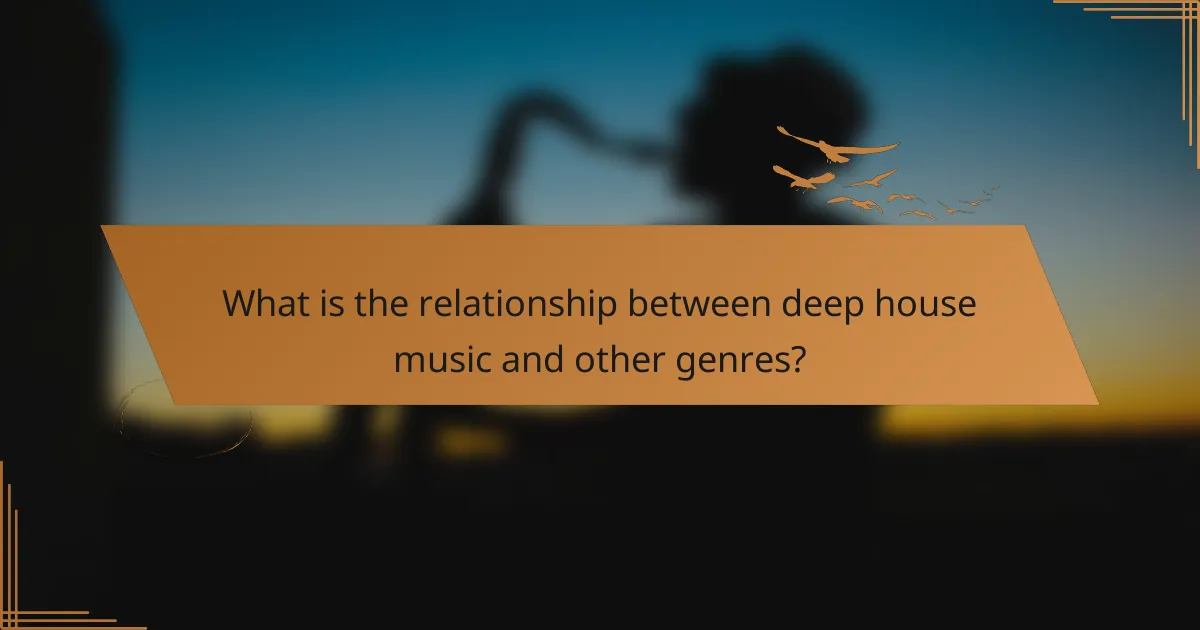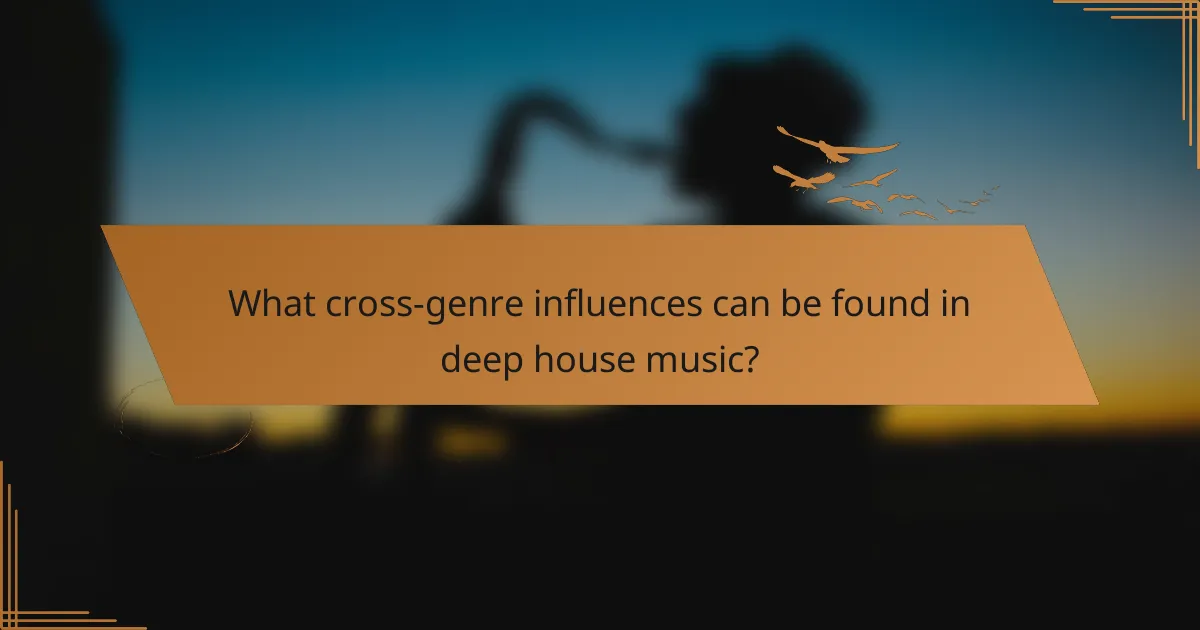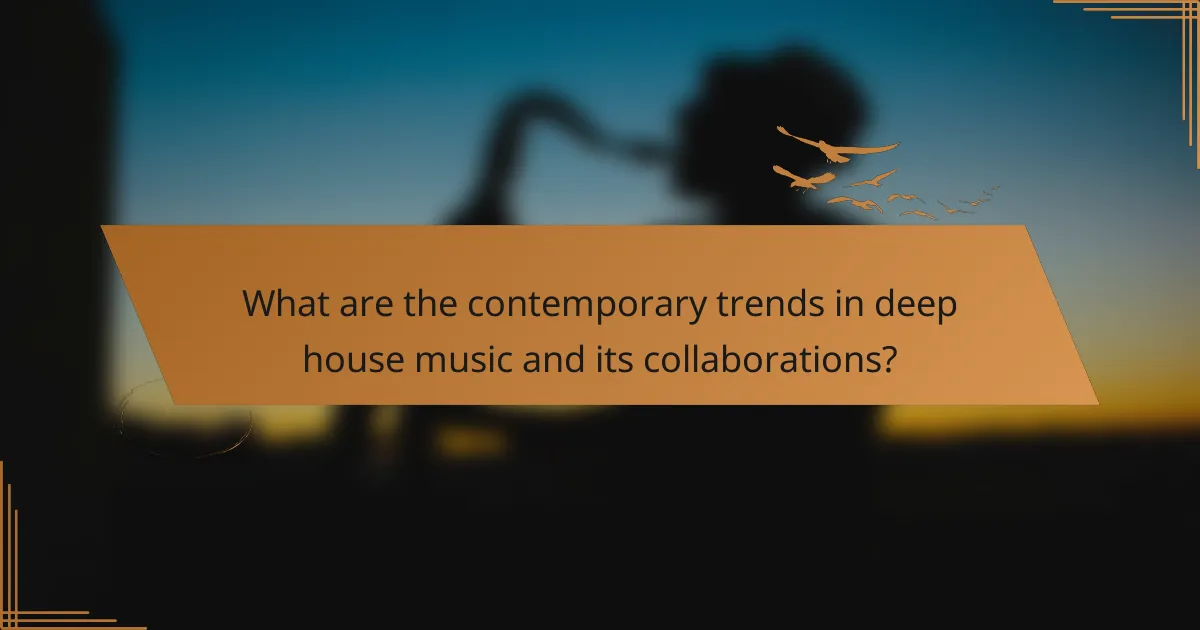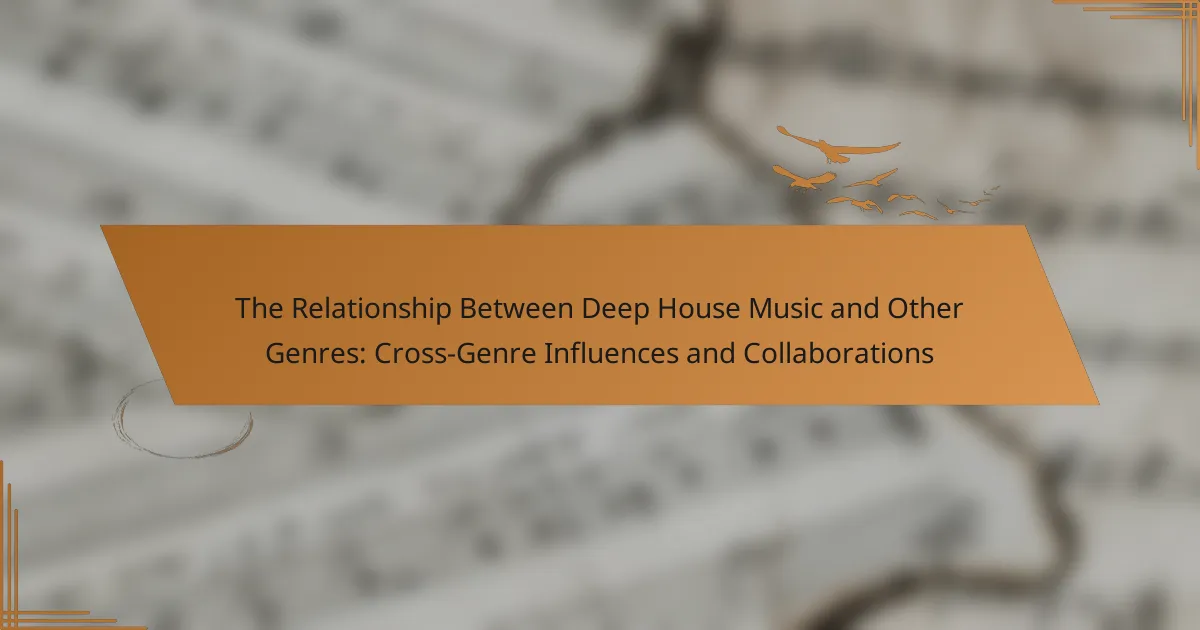Deep house music is a genre that blends elements from various musical styles, including house, jazz, soul, funk, and ambient music. This article explores the intricate relationship between deep house and these genres, highlighting how influences from R&B, pop, and techno shape its sound. It also examines contemporary trends such as genre blending and collaborations, which have enhanced the accessibility and diversity of deep house music. Notable examples of these collaborations are discussed, showcasing how artists integrate different styles to create innovative tracks. Overall, the evolving nature of deep house reflects a dynamic interplay of cross-genre influences and partnerships.

What is the relationship between deep house music and other genres?
Deep house music has strong connections with several other genres. It originates from house music, incorporating elements of jazz, soul, and funk. The use of smooth basslines and melodic chords is a common feature shared with these genres. Additionally, deep house often integrates vocals, which can be influenced by R&B and pop music.
The genre also draws inspiration from ambient and downtempo music, creating atmospheric soundscapes. Collaborations between deep house artists and musicians from other genres have become increasingly popular. These collaborations often result in unique blends that push the boundaries of traditional deep house.
For example, artists like Disclosure have successfully fused deep house with elements of pop and electronic dance music. This cross-genre influence helps to expand the audience for deep house, making it more accessible. Thus, the relationship between deep house music and other genres is characterized by a blend of influences and collaborative efforts.
How did deep house music evolve alongside other genres?
Deep house music evolved through its integration with various genres, including jazz, soul, and techno. Originating in the 1980s, it absorbed elements from these styles. The genre is characterized by its smooth, soulful melodies and a slower tempo. Jazz influences are evident in its use of chords and instrumentation. Soul music contributed to deep house’s emotive vocal styles. Techno’s rhythmic structures and electronic sounds also shaped its development. The collaboration between artists across these genres has further enriched deep house. Notable collaborations have led to innovative sounds and expanded its audience. This evolution reflects the genre’s adaptability and ongoing relevance in the music scene.
What are the historical influences that shaped deep house music?
Deep house music is shaped by various historical influences, primarily rooted in Chicago house, disco, and jazz. Chicago house emerged in the 1980s, characterized by its rhythmic beats and synthesizer use. Disco’s influence brought a focus on danceability and soulful vocals. Jazz elements introduced complex harmonies and improvisational styles into deep house tracks. The blending of these genres created a unique sound that emphasizes mood and atmosphere. Key artists like Frankie Knuckles and Larry Heard played crucial roles in this development. Their work helped define the deep house genre during its formative years. Additionally, the use of sampling from older records added depth and texture to the music. Overall, deep house music reflects a rich tapestry of influences that continue to evolve.
How do cultural movements impact the evolution of deep house music?
Cultural movements significantly influence the evolution of deep house music. These movements shape the themes, sounds, and aesthetics within the genre. For example, the rise of the [censured] rights movement in the 1980s contributed to the popularity of house music in clubs. This cultural backdrop led to the integration of diverse sounds and influences. The emergence of the underground rave culture in the 1990s introduced elements of techno and trance into deep house. Additionally, the hip-hop culture has influenced deep house through sampling and rhythmic patterns. As societal values shift, deep house music adapts to reflect these changes. This adaptability ensures that deep house remains relevant across generations.
What are the key characteristics of deep house music?
Deep house music is characterized by its soulful melodies and smooth basslines. The genre typically features slower tempos, often ranging from 120 to 125 beats per minute. Deep house incorporates elements from jazz, funk, and soul, creating a rich harmonic structure. Vocals in deep house are often soft and emotive, enhancing the overall atmosphere. The use of lush synthesizers and ambient pads is common, contributing to its immersive sound. Deep house tracks often include intricate percussion patterns, adding depth to the rhythm. The genre emerged in the 1980s, influenced by Chicago house music and Detroit techno. Its evolution has led to diverse subgenres, showcasing its adaptability and cross-genre collaborations.
How does deep house music differ from other electronic genres?
Deep house music differs from other electronic genres primarily through its unique sound characteristics. It features a slower tempo, typically ranging from 120 to 125 BPM. Deep house incorporates complex melodies and harmonies, often using jazz and soul influences. The genre emphasizes deep basslines and atmospheric sounds, creating a laid-back vibe. Vocals in deep house are often smooth and soulful, contrasting with the more aggressive styles found in genres like techno or dubstep. Additionally, deep house often includes elements of house music, such as four-on-the-floor beats, but distinguishes itself through its emotional depth and intricate production techniques. This combination of attributes sets deep house apart from other electronic genres, making it a distinct and recognizable style.
What are the defining elements of deep house music production?
Deep house music production is characterized by its use of soulful melodies, smooth basslines, and intricate rhythms. The genre typically incorporates elements of jazz, funk, and soul. A prominent feature is the use of deep bass, which creates a rich, warm sound. Vocals in deep house are often smooth and emotive, enhancing the overall feel of the track. The tempo generally ranges from 120 to 125 BPM, providing a laid-back yet danceable groove. Production techniques often include atmospheric pads and synths, which add depth and texture. Additionally, deep house frequently employs sampling from older tracks, reinforcing its connection to musical heritage. These elements collectively define the unique sound of deep house music.

What cross-genre influences can be found in deep house music?
Deep house music is influenced by various genres, including jazz, soul, and funk. Jazz elements are evident in the use of complex chords and improvisational aspects. Soul music contributes to the emotive vocal styles often found in deep house tracks. Funk influences the rhythmic grooves and basslines characteristic of the genre. Additionally, elements of disco are present, particularly in the upbeat tempo and danceability. The incorporation of ambient music creates atmospheric soundscapes in deep house. Techno and house music also play significant roles in shaping its structure and production techniques. These cross-genre influences create a rich and diverse sound within deep house music.
How does deep house music incorporate elements from other genres?
Deep house music incorporates elements from genres like jazz, soul, and funk. It often features smooth, soulful vocals that are a hallmark of these genres. The use of jazzy chords and harmonies is common in deep house tracks. Funky basslines provide a rhythmic foundation, enhancing the groove. Additionally, deep house frequently employs samples from classic soul and jazz records. This blending creates a rich, layered sound. The genre also embraces electronic and techno influences, contributing to its unique style. Overall, deep house music reflects a diverse sonic palette, showcasing its cross-genre influences.
What genres have had the most significant influence on deep house music?
The genres that have had the most significant influence on deep house music are Chicago house, jazz, and soul. Chicago house laid the foundational beats and structure for deep house. Jazz contributes complex chord progressions and improvisational elements. Soul adds emotional depth and vocal styles. Each genre shapes deep house’s unique sound. The integration of these influences creates a rich auditory experience.
How do artists blend deep house with other musical styles?
Artists blend deep house with other musical styles by incorporating elements from genres like jazz, funk, and soul. They often use jazzy chord progressions and soulful vocals. This fusion creates a richer auditory experience. Additionally, artists may integrate rhythmic patterns from genres such as hip-hop and disco. The use of live instruments, like saxophones and pianos, enhances this blend. Collaborations with artists from different genres also facilitate this mixing. Notable examples include tracks that combine deep house with techno or ambient music. Such cross-genre influences expand the appeal of deep house. This blending process contributes to the evolution of the deep house genre itself.
Why are collaborations important in the deep house music scene?
Collaborations are important in the deep house music scene because they enhance creativity and innovation. By working together, artists blend different styles and techniques. This fusion leads to unique sounds that can attract diverse audiences. Collaborations also help artists reach new fan bases. For instance, a deep house artist teaming up with a pop singer can introduce deep house to pop fans. Additionally, collaborations often result in higher production quality. Artists can share resources and expertise, improving the overall sound. Finally, collaborations foster community within the music scene. They encourage networking and support among artists, which can lead to more opportunities.
What are some notable collaborations between deep house artists and musicians from other genres?
Notable collaborations between deep house artists and musicians from other genres include “Can’t Get Enough” by Soulsearcher featuring vocalist “Javine Hylton.” This track blends deep house with pop influences. Another example is “I Feel for You” by Bob Sinclar featuring “Shabba Ranks,” merging deep house with reggae elements. “Let Me Go” by the deep house duo “Duke Dumont” features the vocals of “Jax Jones,” showcasing a fusion with electronic pop. Additionally, “Cola” by CamelPhat and Elderbrook combines deep house with indie and electronic sounds. These collaborations highlight the versatility and cross-genre appeal of deep house music.
How do collaborations enhance the creativity of deep house music?
Collaborations enhance the creativity of deep house music by combining diverse musical influences. When artists from different genres collaborate, they introduce unique sounds and styles. This fusion leads to innovative rhythms and melodies that enrich deep house tracks. Collaborations also encourage experimentation with new production techniques. For instance, blending deep house with elements of jazz or funk can create fresh auditory experiences. Additionally, partnerships often result in a broader emotional range in the music. The interplay of various artistic visions stimulates creativity and pushes boundaries. Ultimately, collaborations expand the sonic palette of deep house music, making it more dynamic and engaging.

What are the contemporary trends in deep house music and its collaborations?
Contemporary trends in deep house music include increased genre blending and collaborations with artists from various musical backgrounds. Deep house now frequently incorporates elements from genres like techno, R&B, and pop. Collaborations often feature vocalists and producers who bring diverse styles, enriching the sound. This trend is evident in tracks that merge deep house beats with soulful melodies and catchy hooks. The rise of online platforms has facilitated these collaborations, enabling artists to connect globally. Notable examples include deep house tracks featuring hip-hop artists, which have gained significant popularity. The use of live instruments in production has also become more common, adding depth to the sound. Overall, deep house continues to evolve through innovative partnerships and cross-genre experimentation.
How are modern artists shaping the future of deep house music?
Modern artists are shaping the future of deep house music through innovative collaborations and genre blending. They incorporate elements from electronic, jazz, and ambient music. This fusion creates unique soundscapes that attract diverse audiences. For example, artists like Disclosure and Kaytranada mix deep house with pop and hip-hop influences. Their tracks often feature soulful vocals and intricate production techniques. Additionally, modern technology allows artists to experiment with sounds and production methods. This accessibility encourages more experimentation within the genre. As a result, deep house continues to evolve, maintaining its relevance in the contemporary music scene.
What innovative techniques are being used in contemporary deep house music?
Contemporary deep house music employs innovative techniques such as sampling, live instrumentation, and intricate sound design. Sampling involves incorporating snippets from various genres, creating a fusion of sounds. Live instrumentation adds an organic feel, enhancing the emotional depth of tracks. Intricate sound design utilizes advanced software and hardware to craft unique textures. Additionally, the use of vocal manipulation techniques, like pitch shifting and time stretching, adds complexity. Collaborations with artists from other genres introduce fresh influences. These methods contribute to the evolving landscape of deep house music, making it dynamic and diverse.
How do social media and technology influence deep house collaborations today?
Social media and technology significantly influence deep house collaborations today. They provide platforms for artists to connect globally. Social media allows musicians to share their work instantly. This increases visibility and accessibility for collaborations. Technology facilitates remote music production. Artists can collaborate without being in the same location. Tools like digital audio workstations enable seamless integration of different sounds. Streaming services promote collaborative tracks, boosting their reach. According to a 2021 survey, 70% of artists reported using social media for collaboration opportunities. This shows the pivotal role of technology in modern music partnerships.
What tips can emerging artists follow to collaborate successfully in deep house music?
Emerging artists can collaborate successfully in deep house music by establishing clear communication. Effective dialogue ensures all parties understand their roles and expectations. Artists should also share their creative visions early in the process. This alignment fosters a cohesive sound.
Additionally, exploring each other’s strengths can enhance the collaboration. Identifying unique attributes allows artists to utilize their best skills. Scheduling regular check-ins during the collaboration helps maintain momentum. This practice keeps everyone engaged and accountable.
Networking within the deep house community is also crucial. Attending events and connecting with other artists can lead to new opportunities. Finally, being open to feedback promotes growth and improvement. Constructive criticism can refine the final product and strengthen relationships.
How can artists identify potential collaborators in the deep house scene?
Artists can identify potential collaborators in the deep house scene by networking within the community. Engaging in online platforms like SoundCloud and Bandcamp helps artists discover others’ work. Attending deep house events and festivals fosters direct connections with like-minded musicians. Collaborating with producers and DJs can enhance visibility and open doors to new partnerships. Social media platforms, especially Instagram and Facebook groups, serve as valuable resources for finding collaborators. Listening to local radio stations or podcasts dedicated to deep house can reveal emerging talent. Analyzing collaborations between established artists often highlights potential partners. These methods allow artists to build relationships and create impactful music together.
What best practices should artists consider when collaborating across genres?
Artists should prioritize open communication when collaborating across genres. Clear dialogue helps establish mutual understanding and respect. Setting shared goals is essential for aligning creative visions. Artists should also be flexible and willing to experiment with different styles. This adaptability can lead to innovative outcomes. Establishing boundaries ensures each artist’s contributions are valued. Regular feedback sessions can enhance the collaborative process. Artists can also benefit from researching each other’s genres to gain insight. This knowledge fosters creativity and enriches the collaboration.
Deep house music is the primary entity explored in this article, which examines its relationship with various genres and the impact of cross-genre collaborations. The article outlines the historical influences that shaped deep house, including Chicago house, jazz, and soul, while highlighting the genre’s key characteristics such as smooth basslines and emotive vocals. It discusses contemporary trends, innovative techniques, and the role of social media and technology in fostering collaborations among artists. Additionally, the article provides practical tips for emerging artists seeking to collaborate successfully within the deep house scene, emphasizing the importance of communication and networking.
